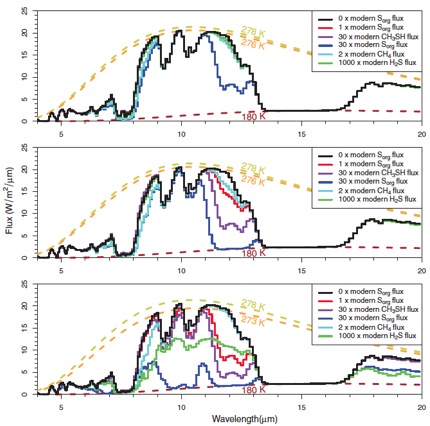2011 Annual Science Report
 VPL at University of Washington
Reporting | SEP 2010 – AUG 2011
VPL at University of Washington
Reporting | SEP 2010 – AUG 2011
Detectability of Biosignatures
Project Summary
In this project VPL team members explore the nature and detectability of biosignatures, global signs of life in the atmosphere or on the surface of a planet. This year we completed and published our work on the build up and detectability of sulfur-based biosignatures in early Earth-like atmospheres, especially for planets orbiting stars cooler than our Sun. We also continued to explore the potential non-biological generation of oxygen and ozone in early Earth-like atmospheres, which could result in a “false positives” for photosynthetic life. In parallel, we worked with three simulators for telescopes that will one day be able to observe and determine the properties of extrasolar terrestrial planets, and used these simulators to calculate the relative detectability of gases produced by life.
Project Progress
Detectability of an Anoxic Planet: For a third of life’s history on Earth, the planet’s atmosphere was anoxic. In such an environment, two of the main biosignature gases (O2 and O3) would not build up to detectable concentrations. In the past year, we published a paper (Domagal-Goldman et al.) wherein we show how other gases could be used as biosignatures for such a planet. Specifically, we examined the detectability of biogenic sulfur gases. We found that for extremely high production rates of these gases, or for planets around stars with low UV-fluxes, these gases would be directly detectable. We furthermore
found that for lower (modern-day) fluxes on planets around Sun-like stars, the effects of these gases on atmospheric chemistry could be detected via an increase in the planet’s ethane:methane ratio. This work could have a significant impact on future exoplanet mission plans, as it lays out a strategy for finding life on an anoxic planet, a type of biosphere that could represent a significant portion of the inhabited planets in the universe. (FIGURE 1)

Figure Caption: Spectra for planets around the Sun (top panel), AD Leo (middle panel), and T3100, a model M dwarf with no chromosphere (bottom panel), all at a spectral resolution of λ/Δλ~50. The black curve is a spectrum for a planet with 0 organic sulfur flux. The red and blue lines show model spectra for planets with 1 and 30 times the modern organic sulfur fluxes. The purple lines show spectra for planets with 30 times the modern day flux of CH3SH and 0.65 times the modern day flux of CH4. The cyan lines show spectra with 2 times the modern day flux of CH4 and 0 organic sulfur flux. The green lines show spectra with 1000 times the modern day flux of H2S and 0 organic sulfur flux. The goldenrod, orange, and brown dashed lines represent the Planck function for an object at 278K (the surface temperature), 276 or 273K (the highest ‘‘color temperature’’ for the ‘‘1 modern organic sulfur flux’’ spectrum), and 180K (the stratospheric temperature). Note how as organic sulfur fluxes increase, so too does the absorption feature centered on 12 μm, which is due to ethane. This change in ethane:methane ratio not reproducible by increasing methane fluxes, as shown by the red line (double methane flux), which can recreate the methane aborption feature but not the ethane absorption feature. At high organic sulfur fluxes, and around stars with low UV radiation, the organic sulfur gases are directly detectable through additional absorption between 9-12 μm.
Detectability of Planetary Characteristics and Biosignatures for the three TPF Architectures: We have obtained and are now running simulators for Terrestrial Planet Finder Coronograph (S. Heap and D. Lindler), Interferometer (T. Velusamy) and Occulter (W. Cash) mission concepts. We are using these simulators to explore the detectability of signs of habitability and biosignatures from oxygenic photosynthetic, as well as the other metabolisms described here (Evans et al., 2011). We find that it is in fact easier to detect signs of photosynthesis on cloud-covered Earth-like planets, due to the tendency for oxygen
to be evenly mixed, and ozone to be concentrated above the cloud layer.
Publications
-
Domagal-Goldman, S. D., Meadows, V. S., Claire, M. W., & Kasting, J. F. (2011). Using Biogenic Sulfur Gases as Remotely Detectable Biosignatures on Anoxic Planets. Astrobiology, 11(5), 419–441. doi:10.1089/ast.2010.0509
- Barnes, R., Meadows, V.S., Domagal-Goldman, S.D., Heller, R., Jackson, B., Lopez-Morales, M., Tanner, A., Gomez-Perez, N. & Ruedas, T. (2010). Habitability of Planets Orbiting Cool Stars [Online]. Website: http://adsabs.harvard.edu/abs/2010arXiv1012.1883B.
- Evans, N., Meadows, V.S. & Domagal-Goldman, S.D. (2011). Exploring The Detectability of Terrestrial Exoplanet Characteristics. Bulletin of the American Astronomical Society.
- Meadows, V. (2011). Detecting Planetary Habitability. Bulletin of the American Astronomical Society.
-
PROJECT INVESTIGATORS:
-
PROJECT MEMBERS:
Mark Claire
Co-Investigator
James Kasting
Co-Investigator
Nicole Evans
Undergraduate Student
-
RELATED OBJECTIVES:
Objective 1.1
Formation and evolution of habitable planets.
Objective 1.2
Indirect and direct astronomical observations of extrasolar habitable planets.
Objective 4.1
Earth's early biosphere.
Objective 7.2
Biosignatures to be sought in nearby planetary systems

